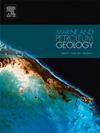Linking diagenesis to sequence stratigraphy: An integrated approach for understanding and predicting the reservoir quality distribution of the Ilam Formation (Santonian) in Abadan Plain, southwest of Iran
IF 3.7
2区 地球科学
Q1 GEOSCIENCES, MULTIDISCIPLINARY
引用次数: 0
Abstract
The Santonian Ilam Formation, is one of the most important hydrocarbon reservoirs in the Abadan Plain, southwestern Iran. The aim of this study is to evaluate the diagenetic processes and products in a sequence stratigraphic framework by combining the results of core description, the study of microscopic thin sections and petrophysical diagrams from the perspective of facies, diagenetic features, and reconstruction of the depositional environments. Petrographic studies were performed on 235 thin sections from drill cuttings from four wells and about 124 m of core samples from two key wells across four oil fields in the study area. Facies analysis identified seven carbonate microfacies belonging to lagoon, shoal, and open marine facies belts. The findings indicate that the Ilam Formation was deposited in a homoclinal carbonate ramp platform. Sequence stratigraphic investigations led to the identification of two third-order depositional sequences. Diagenetic processes affecting include dissolution, recrystallization and dolomitization, mainly observed dominant in the late highstand systems tract of the lower Santonian depostional sequence. In the early TST and late HST stages, due to increased accommodation space, marine diagenetic processes such as micritization and cementation are more extensive. Due to the development of grain-supported microfacies, dissolution processes and the development of vuggy and moldic porosity are more prevalent. In the late TST stages, favorable conditions for low-energy environment microfacies and in the early HST stages, with the decline in relative sea level rise rate and reduced accommodation space, have expanded.
求助全文
约1分钟内获得全文
求助全文
来源期刊

Marine and Petroleum Geology
地学-地球科学综合
CiteScore
8.80
自引率
14.30%
发文量
475
审稿时长
63 days
期刊介绍:
Marine and Petroleum Geology is the pre-eminent international forum for the exchange of multidisciplinary concepts, interpretations and techniques for all concerned with marine and petroleum geology in industry, government and academia. Rapid bimonthly publication allows early communications of papers or short communications to the geoscience community.
Marine and Petroleum Geology is essential reading for geologists, geophysicists and explorationists in industry, government and academia working in the following areas: marine geology; basin analysis and evaluation; organic geochemistry; reserve/resource estimation; seismic stratigraphy; thermal models of basic evolution; sedimentary geology; continental margins; geophysical interpretation; structural geology/tectonics; formation evaluation techniques; well logging.
 求助内容:
求助内容: 应助结果提醒方式:
应助结果提醒方式:


